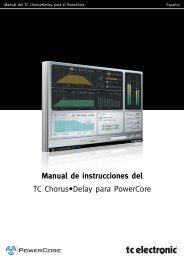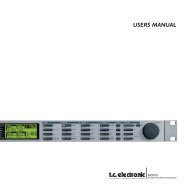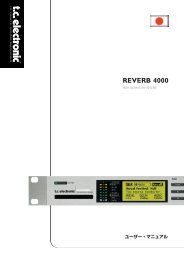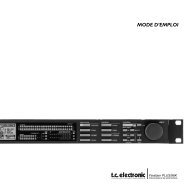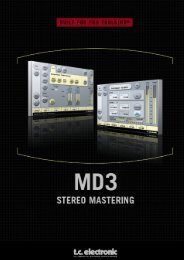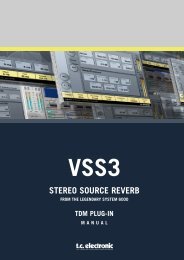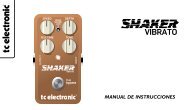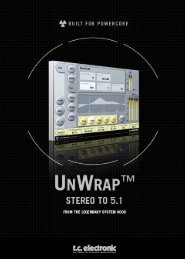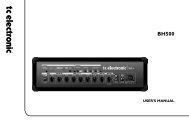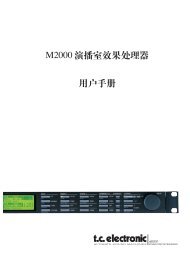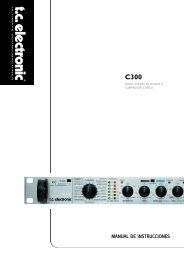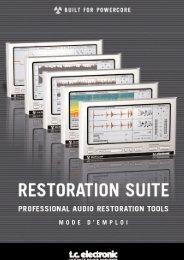EQ Station Manual v. 2.01 sw. 220 English - TC Electronic
EQ Station Manual v. 2.01 sw. 220 English - TC Electronic
EQ Station Manual v. 2.01 sw. 220 English - TC Electronic
You also want an ePaper? Increase the reach of your titles
YUMPU automatically turns print PDFs into web optimized ePapers that Google loves.
GRAPHICAL <strong>EQ</strong> TYPES IN THE <strong>EQ</strong> STATION<br />
Hybrid parallel/cascade structure<br />
A compromise between the pure parallel and the pure<br />
cascade structure is possible too. By implementing the<br />
even-numbered bands in one parallel-type <strong>EQ</strong> and the<br />
odd-numbered bands in another and then connect the two<br />
in cascade, we get the cascade-structure type of gain<br />
build-up between adjacent bands, and other bands with an<br />
odd number of band steps between them, and the parallelstructure<br />
type of gain build-up between bands with an even<br />
number of band steps between them.<br />
Conclusion<br />
Figure 10 - Six-band all-boost (i.e. feed-forward only)<br />
extract of Hybrid structure <strong>EQ</strong>. The hybrid structure is<br />
used in <strong>EQ</strong> <strong>Station</strong>'s 'Classic960' algorithms.<br />
Structure comparison with 3 adjacent bands set to +3dB<br />
Let's see what response these three structures will produce<br />
if we set 3 adjacent 1/3 octave bands with Q = 2 to +3dB:<br />
Figure 12 - Extreme example of inter-band gain buildup:<br />
All bands set to +3dB<br />
Filter structure consequences with a 3dB boost on all<br />
bands<br />
• The <strong>TC</strong> 1128 (Parallel) type adds<br />
a total of approx: 7dB<br />
• The 960 (Hybrid) type adds a total of approx: 8dB<br />
• The Classical 27 (Cascaded type) ads a total of<br />
approx: 10.5dB<br />
As we have seen, a graphical equalizer is characterized<br />
not only by its center frequencies and gain range but also<br />
by its boost/cut symmetry, its Q (or bandwidth) as a<br />
function of gain setting and its inter-band gain build-up<br />
which depends on the implementation structure.<br />
The <strong>EQ</strong> <strong>Station</strong> facilitates the commonly used graphic <strong>EQ</strong><br />
types in the recent past and should therefore be easy and<br />
straight forward to use for anyone no matter your level of<br />
experience.<br />
Figure 11 - Examples of inter-band gain build-up with<br />
identical settings and Q but 3 different implementation<br />
structures<br />
With all bands set to +3dB the difference between<br />
implementation structures becomes even more<br />
pronounced:<br />
16




